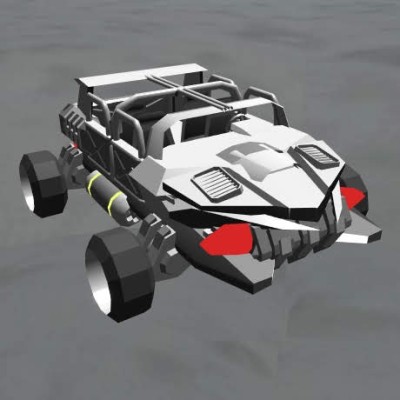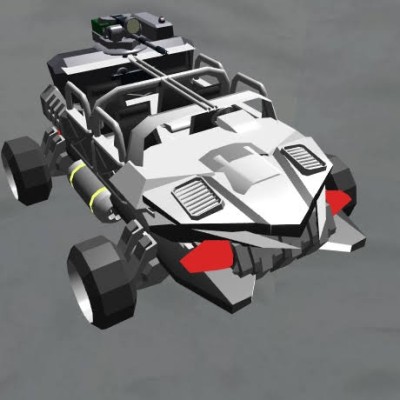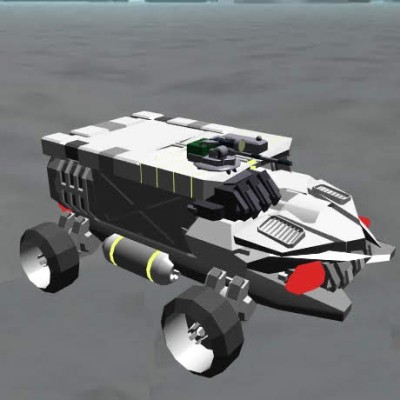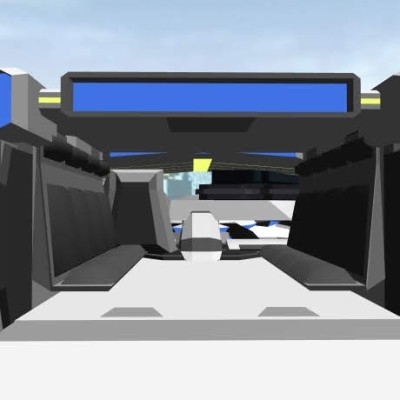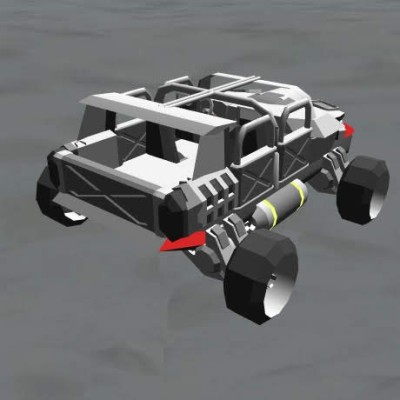Table of Contents
BW-MRGT "Hound"
The MRGT, or Multi-Role Ground Transport, was designed by Section 6 in YE 40 and is a four-wheel drive jeep that can be configured to fill the roles of transport, lightly armed transport, and armored personnel carrier (APC). It can also armed with a turret-mounted heavy anti-infantry weapon such as a grenade launcher or chaingun.
About the BW-MRGT
The S6-MRGT “Hound” is a fast and configurable four-wheel drive ground transport that was designed to safely and quickly get troops to where they need to go. It can be armed with a turret-mounted weapon, but is only strong enough to combat enemy power armor and is not meant to go toe to toe with enemy armor such as tanks and mecha.
Key Features
Here are some of the vehicle's distinguishing features.
- Fast and light with the exception of its APC configuration.
- Configurable for various transportation and defensive needs.
- Each wheel axle is an independent bearing, which allows for better terrain handling and improved vehicle reliability.
History
In late YE 40, Section 6 knew they would need a reliable off-road vehicle for traveling on the diverse terrain present on Sirris VI. The Hound was drafted and designed in the coming weeks of settling in on their new home. The Department Of Engineering (D.O.E.) studied their data from previous operations in different terrains and put it into the overall design. It was decided that independent axles were the way to go and that plasma was the most viable source of fuel that they had been using.
Another consideration was the various tasks needed of such a vehicle, thus to cut down costs and the production of more vehicle designs the Hound was designed to be semi-modular. Its chassis allows for certain parts to be swapped and rearranged for different roles. The Hound can be set up as a standard jeep (cargo and transport), a turret-mounted jeep( armored ground transport), or an up-armored APC (armored personnel carrier).
Appearance
Here are textual descriptions and art for each variant of the S6-MRGT “Hound”.
Jeep
The “Hound” has a very blocky and rough body - with its features projecting its role as an all-terrain vehicle pretty clearly - and its front has an almost blade-like sharp pointed appearance. All four tires are on independent axles and lack any sort of wheel well covers. Overall, the vehicle is rigid, functional, and geometric in its aesthetic. The turret-mounted variant of the jeep is the same but has a swivel manned turret in the bed.
APC
The APC version of the Hound has the same chassis but features additional heavy armor, a troop bay in the place of the jeep's cargo bed, and a second row of seating. It essentially looks like a rectangular box on wheels but retains the jeep's forward section.
Statistical Information
Here is data related to the manufacturer and general specifications of the vehicle.
- Organization: New Dusk Conclave
- Type: 4WD Ground Transport
- Class: Multirole Ground Vehicle
- Designer: New Dusk Conclave
- Manufacturer: Black Wing Enterprises, Department Of Engineering
- Production: Black Wing Enterprises, Department Of Engineering
Passengers
Here is the data for how many personnel can fit in the vehicle and what positions/stations they can occupy.
Jeep
- Operators: 1
- Passengers: 3
- Max Capacity: 7
Jeep (Turret-Mounted)
- Operators: 22)
- Passengers: 3
- Max Capacity: 5
APC
- Operators: 23)
- Passengers: 8
- Max capacity: 14
Dimensions
Here is the information on the physical parameters for all configurations of the S6-MRGT “Hound”.
Width
Height
Length
- Jeep: 12 feet
- Jeep(Turret-Mounted Variant): 12 feet
- APC: 13.5 feet
Speeds
Below is the data on performance in relation to the vehicle's speed.
Top Speed By Configuration
- Jeep: 200mph
- Jeep (Turret-Mounted): 195mph
- APC: 180mph
Range
- Range: Can travel approximately anywhere terrain allows within 4 months without refuel.
- Lifespan: 20 years with regular maintenance; 5 years without maintenance.
Damage Capacity
See Damage Rating (Version 3) for an explanation of the damage system.
Body
Shields
Interior
Here below is the descriptive appearances of the interior, and their differences between variants.
Jeep
In the center dash of the jeep's interior cabin is the radio, sensor readout display, and GPS. The driver sits to the left, with the steering wheel and a dash display that gives the vehicle's system readouts, to the right is the front passenger seat, behind both is another row of passenger seats, and behind that is the cargo bed of the jeep. The interior is metal with plastic furnishings and gel-padded seats.
Jeep (Turret-Mounted)
The interior of the turret-mounted jeep variant is the same the default jeep model but has an open swivel turret mount in the place of the default model's cargo bed.
APC
For the APC variant, the front passenger seat is replaced with a gunner's seat, while the bed and second row of seating are replaced by a troop bay. A row of four seats lines either side of the troop bay, and the interior is now enclosed in protective armor; lastly, a deployment ramp is added to rear of the vehicle.
Weapons Systems
These are the available options for weapons mountable on the vehicle's turret mounting. Only one of the bulleted item(s), however, can be equipped at one time.
- 3 S6-HAR1-1 Storm Rifles (Burst): Tier 4, Light Anti-Armor
- 3 S6-MWS1-MAVERICK Heavy Sniper Rifles: Tier 3, Heavy Anti-Personnel
- 2 S6-MWS2 "Harbinger" Light Machine Guns: Tier 2, Medium Anti-Personnel
- 2 S6-MWS2 "Harbinger" Heavy Sniper Rifles: Tier 3, Heavy Anti-Personnel
Onboard Systems Descriptions
Here is all the installed subsystems in this vehicle, and their purposes.
- Power: BW-PC-1A Plasma Core
- Safety: Crash bags
Communications System
Communications include satellite (if available), video, vehicle-to-vehicle relay, tight beam (limited to the direction of the beam), and standard radio. There is also a small emergency beacon powered by a cobalt-doped graphene molecular circuit, giving a range of about 30 light-minutes.
Sattelite uplink, video, standard radio, tight beam, and suit relays are handled by a quarter-sized device mounted in the dash and connected to the center console built into said dash. This device is a molecular circuit based noncollinear phased array designed by Sera Cerulius, Rose Ironhart-Pine, and Aster Blake, based on the technology present on the Eye II fleet in Section 6's possession. This particular unit is a mere 1200 elements, delivering a 200 watt simulated signal, or about 5-watt average, with almost three gigabytes per second of bandwidth. However, as with all microwave transmitters, there are significant drawbacks, most of which aren't notable in combat.
Maximum range is approximately 1 to 1.5 light minutes, with a 90-second latency, or signal delay for a one-way trip. This means three minutes minimum between radio bursts. Due to extreme signal degradation, this is not recommended.
The optimal range is between 160 and 42,200 kilometers, giving a minimum of near instantaneous communications at low orbit, or about half a second latency for geosynchronous orbit on average worlds. While not suitable for instantaneous control, the maximum optimal range is primarily used for artillery or orbital combat support with much stronger or different classes of transmitters being used to relay the signal to nearby Section 6 vessels.
Sensors
Shields
On the turret-mounted jeep, shield generators are installed between the wheel wells, in the front of the vehicle within the engine compartment, and in the tailgate section. The APC has a similar setup, however, the rear unit is in the boarding ramp.
Cargo Capacity
The jeep configuration of the S6-MRGT “Hound” comes with a rear cargo bed which can store most medium items\equipment and some larger items\equipment. On all configurations, there also is a cylindrical container on either side which can store anything from an extra power core to addition ammo, food, supplies, tools, or small hand weapons. Finally, there is a glove compartment in front of the passenger seat, which can store some smaller items.
Standard Equipment
The MRGT comes standard with a medkit under the driver's seat, a toolkit under the front passenger seat, and a spare pistol and pad with downloaded maps in the glove compartment. Additionally, the cylindrical container on either side of the vehicle contains an extra power core or a limited supply of ammo, food, and water.
OOC Notes
Jack Pine created this article on 2018/10/14 21:26; Frostjaeger approved it (using the checklist) on 2018/12/08 11:57.
| Products & Items Database | |
|---|---|
| Product Categories | vehicles |
| Product Name | BW-MRGT "Hound" |
| Nomenclature | BW-MRGT |
| Manufacturer | Black Wing Enterprises |
| Year Released | YE 40 |
| Price (KS) | 12 ,000.00 KS |
| DR v3 max | Tier 6 |
